Derinkuyu is the deepest excavated underground city in Cappadocia in the Central Anatolia region of Turkey. A beautiful natural wonder with impressive fairy chimneys and eroded caverns, Cappadocia is an amazing geological spectacle. It is also riddled with extensive subterranean dwellings and secret tunnel passages that various people utilized for shelter across the centuries. There are hundreds of these homes in the region, and Derinkuyu is the most famous. At a depth of more than 250 feet with a capacity of up to 20,000 people, this multi-leveled city contained everything an entire population would need to survive a history riddled with invasions.
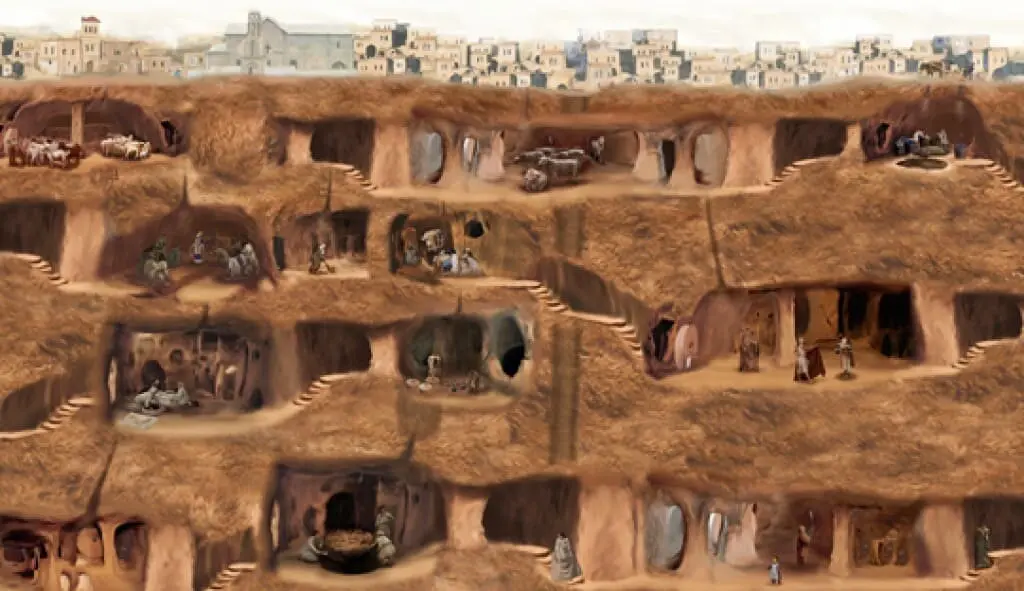
Formation and Discovery
Several million years ago, volcanic eruptions spewed layer after layer of ash, called tuff or tufa. Over time the tuff cemented into a soft, easily carvable, yet relatively stable rock. Inhabitants of ancient Anatolia realized that they could carve out their homes right into the hillsides and underground. Derinkuyu is one of the many rock-cut dwellings in the region, however, it is the deepest one to date.
The discovery of the subterranean dwellings occurred in 1963 during the renovation of a surface home. When a wall caved in, an underground room that led to a subterranean passageway opened up. Upon exploration of the passageway, the workers realized that it led even further into a deep labyrinth. It was an astonishing find.
Features of Derinkuyu
Within the enormous eighteen levels of the city (only eight are accessible), researchers found kitchens, bedrooms, bathrooms, food storage rooms, oil and wine presses, wells, weapons storage areas, churches, schools, tombs, and domestic animal stables. There were rooms of varying sizes for different needs. Small spaces turned out to be rock-cut tombs, while large spaces provided the ideal rooms for community meetings and schools. It is evident that the people planned to be completely self-sufficient. More than fifty ventilation shafts brought in air from above, while thousands of smaller ducts distributed that air throughout the entire city.
Some archaeologists believe that an 8-kilometer long passageway connects Derinkuyu to another amazing underground city in Kaymakli. This suggests that there was some degree of cooperation between the various civilizations of the Cappadocia region.
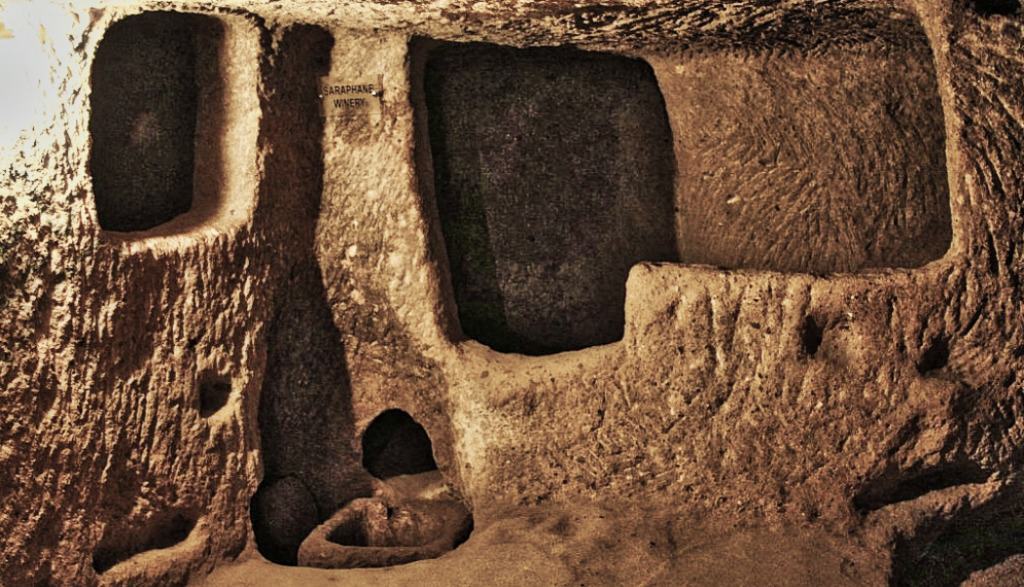
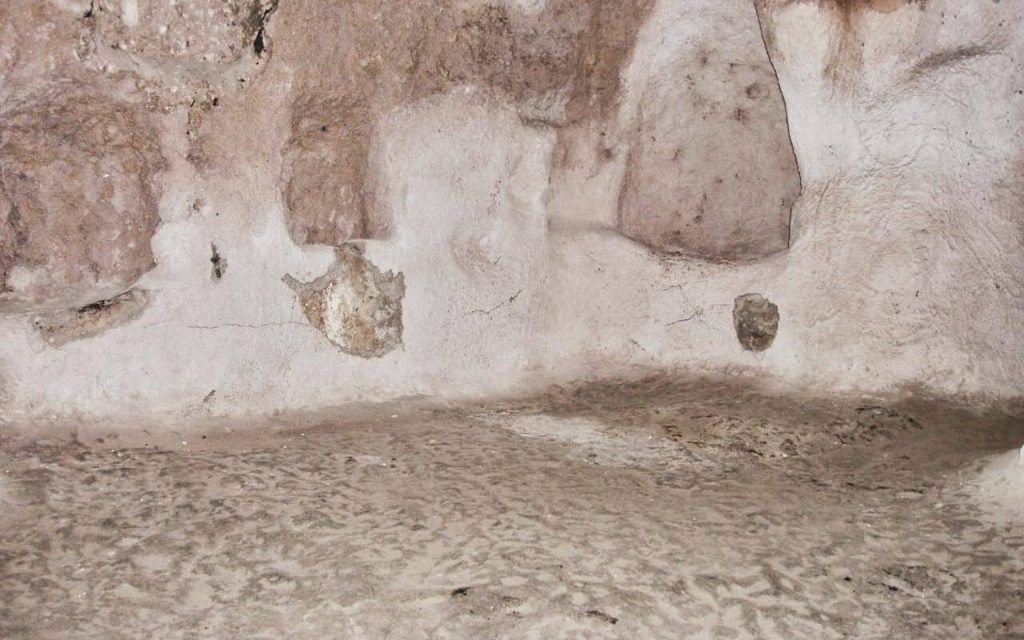
What is the Age of Derinkuyu and Who Built It?
The age of Derinkuyu and who built it are uncertain. It is known that the Hittites dominated the Anatolia region from about 1600 BCE to about 1200 BCE. After this period, the Hittite Empire collapsed into smaller groups, possibly due to multiple invasions and wars. Subsequently, the Phrygians migrated to the area from the Balkans. Thus, if the Hittites built the dwelling, as a number of scholars believe, it may have been well before 1200 BCE.
Other experts theorize that the Phrygians built the subterranean city, which could have taken place between 1200 BCE and 800 BCE. Later, Persians, Macedonians (Alexander the Great), Greeks, Armenians, Syrians, and many other groups had a presence in Cappadocia. The earliest known mention in writing of underground cities in the Cappadocia kingdom came from a Greek historian-soldier named Xenophon in 370 BCE. Xenophon spent time and traveled throughout the region. In his work, Anabasis he says:
[blockquote align=”none” author=”Xenophon”]The houses here were underground, with a mouth like that of a well, but spacious below; and while entrances were tunnelled down for the beasts of burden, the human inhabitants descended by a ladder. In the houses were goats, sheep, cattle, fowls, and their young; and all the animals were reared and took their fodder there in the houses.[/blockquote]
Uses as a Shelter
Foreign Invaders
The history of Derinkuyu and Anatolia as a whole is replete with wars and instability. Some of the earlier known residents of the Cappadocian region, the Hattians (2500 BCE) and later the Hittites, established the area as a valuable trade zone through early association with their Assyrian neighbors. Many tribes and, later, large governments, have aspired to control Anatolia for millennia, due to its location, which served as a major trade hub between Asia and Europe. For these reasons, the areas in Anatolia have historically been extremely volatile and were invaded and conquered repeatedly by different groups.
In 17 CE, the Romans conquered the lands of Cappadocia and made it a Roman province under Emperor Tiberius. During the very early days of Christianity, Christian colonies occupied Cappadocia, and they used the underground cities as safe havens from Roman persecutions.
After the 7th century, Muslim and Persian groups forced Christians once again into hiding. Around this time, there were many Greek Christians who expanded Derinkuyu even further. They continued to use the underground city for refuge into the 20th century, until the early 1900s when Turks massacred hundreds of thousands of Greeks and later forced all the remainders to leave. Many of the Greek lineages had been in the Cappadocia region for thousands of years. After this, they abandoned the underground refuge for good.
Safety Designs
The people who built Derinkuyu designed it with safety features, which indicates that the underground dwellings served as refuges. Doors consisted of a rollable disc-shaped stone with a small hole in the middle that covered entrances and passages during raids. Some people speculate the hole allowed soldiers to shoot arrows out, or perhaps a strong beam through the hole allowed users to open and shut the door more easily. It may also have served as one of the first “peepholes.” Because the doors only opened and closed from the inside, the inhabitants within the complex had complete control. It was much easier to defend the village through a small opening versus a large opening through which anyone could easily walk.
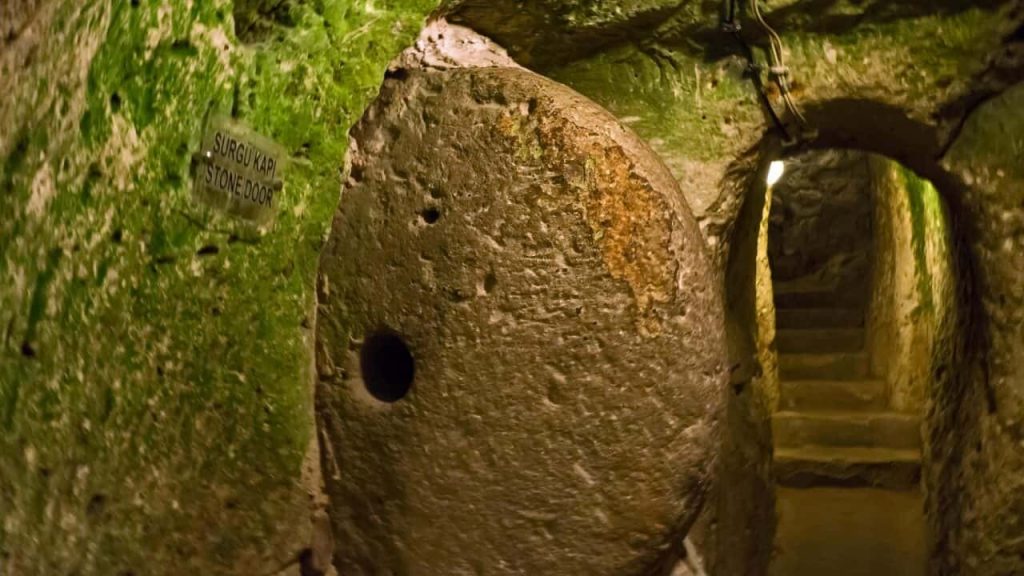
Each level connected to the next level by a hallway with a similar stone door. Additionally, narrow passages forced people to go through in single file. Again, this made it much easier to defend against incoming soldiers.
The underground city had a water containment system that also took safety as a consideration. It appears that one of the main ventilation shafts also served as a large well. However, the wells within the city did not all link together, nor did they all go to the surface. This protected inhabitants from invaders who might think to poison the entire water system from the outside.
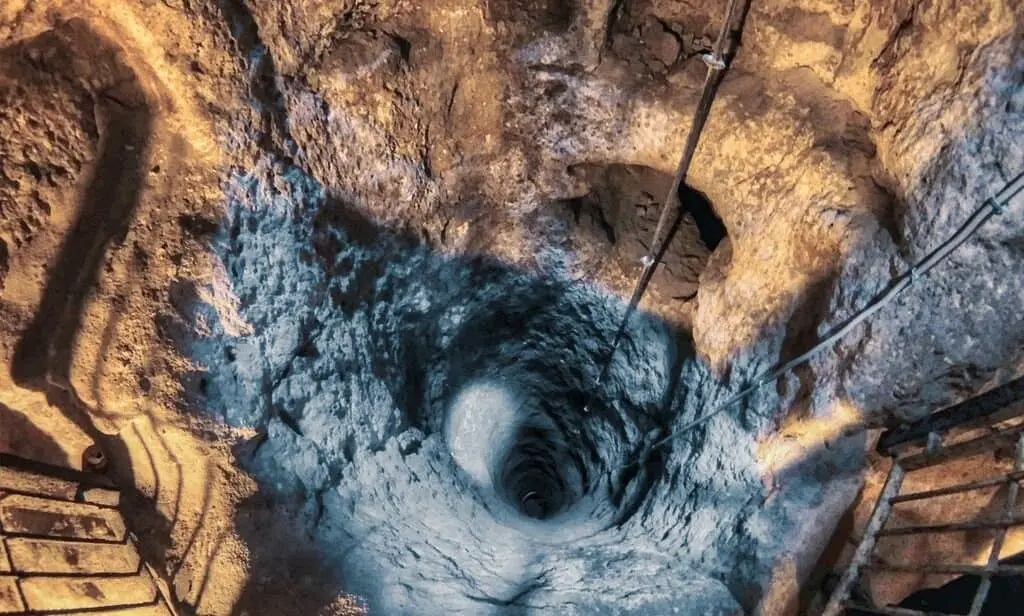
Natural Elements
Derinkuyu also provided protection from the weather which was very hot in the summer and very cold and snowy in the winter. Daily temperatures also fluctuated widely. Underground, the temperature was fairly stable throughout the year at around 55 degrees, which made it ideal for keeping animals cool, maintaining fresh water supplies, and keeping food fresh.
Derinkuyu From Afar
Cappadocia and Derinkuyu are amazing places with incredible histories and beautiful ancient dwellings that go deep underground. Many people would dream of visiting these places, however, it may be best to look from afar. Although there are many travel companies eager to give tours, at this time, the U.S. State Department has a Travel Warning out for Turkey due to ongoing terrorist activities. The Department is currently discouraging any travel to that region.
References:
Argeus
Research Gate